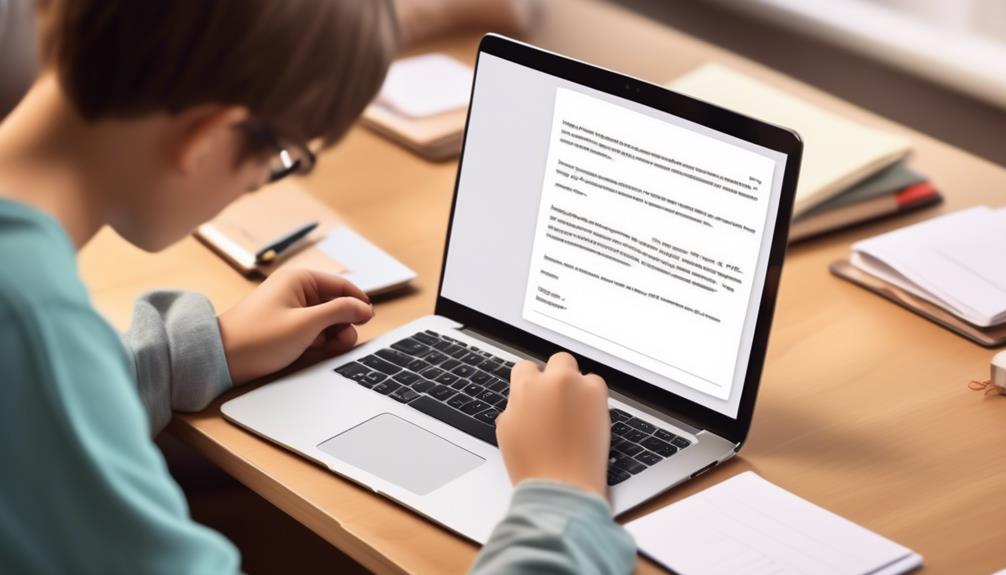We all know the adage that first impressions matter greatly, and in the realm of school emails, the subject line serves as the introductory performance. It establishes the mood and grabs the recipient’s interest, enticing them to dive into the ensuing content.
But there's more to crafting an effective school email than just the subject line. We'll explore the key elements that make a school email stand out and leave a lasting impression, ensuring that your communication is both professional and impactful.
Key Takeaways
- Craft a specific and informative subject line that accurately reflects the content of the email.
- Organize the email content logically and prioritize key information in the opening paragraph.
- Address the recipient by their proper title and last name, using a formal greeting.
- Maintain a respectful and professional tone throughout the email, using formal and respectful language.
Crafting a Clear Subject Line
Craft a specific and informative subject line to clearly summarize the purpose of your school email, helping recipients organize and prioritize their inbox effectively.
When writing the subject line, it's crucial to be professional and direct.
Including the recipient's first name can also personalize the email and make it more engaging.
For instance, instead of a vague subject line like 'Important Information,' a more effective approach could be 'Math 101 Exam Details – Action Required, [Recipient's First Name].'
This not only conveys the specific purpose of the email but also prompts the recipient to take action.
Additionally, including specific details such as course codes or keywords relevant to the email content can make the subject line more informative and relevant.
It's essential to ensure that the subject line accurately reflects the content of the email, as this can significantly impact whether the email gets opened.
Ultimately, a clear and direct subject line not only helps the recipient manage their emails efficiently but also increases the likelihood of your email being read and responded to.
Structuring Your Email

When structuring your email, it's important to organize the content logically and prioritize key information in the opening paragraph. Writing professional emails requires a clear and concise structure that makes it easier for the recipient to understand the purpose of the email.
For high school students writing an email for the first time, it's essential to keep it simple and to the point.
Start by crafting a good subject line that accurately reflects the purpose of the email. In the opening paragraph, clearly state the reason for writing the email. Whether it's a query, a request, or an update, the main purpose should be evident from the beginning. This approach not only helps the recipient understand the email's intention but also makes it easier for them to respond promptly.
When structuring the body of the email, break down the content into short, digestible paragraphs. This makes the email easier to read and comprehend.
Addressing the Recipient
Address the recipient by their proper title and last name, maintaining a respectful and professional tone throughout the email. When writing a professional email, it's essential to address the recipient using their full name and appropriate title. If the recipient is someone the sender knows well and has been invited to use their first name, it's still advisable to maintain a more formal approach to avoid being overly familiar. Beginning the email with a formal greeting, such as 'Good morning,' 'Good afternoon,' or 'Good evening,' sets the right tone for the conversation. It's crucial to err on the side of caution and maintain a proper, professional tone throughout the email, especially if it's the first point of contact or the sender is unsure of how familiar to be.
| Proper Title | Full Name | Contact Information |
|---|---|---|
| Dr. | Smith | drsmith@email.com |
| Professor | Johnson | profjohnson@email.com |
| Mr. | Brown | mrbrown@email.com |
Ensuring that the recipient's full name, proper title, and contact information are included sets a professional standard for the email.
Maintaining a Respectful Tone

Maintaining a respectful tone in school emails is crucial for fostering positive and professional communication with faculty and staff. When writing an email, the subject line tells the recipient what the email is about, so it's important to make it clear and relevant.
In the body of the email, it's essential to maintain a respectful tone by using formal and respectful language. Let the recipient know why you're reaching out and what you need to know. It's also important to make sure to address the recipient by their proper title and last name unless you have been invited to use their first name.
The main purpose of the email should be clearly stated, and overly casual language should be avoided to maintain a professional tone. Additionally, using an appropriate greeting and closing can show respect and courtesy. End your email with a polite closing, such as 'Sincerely' or 'Best regards,' and express that you're looking forward to their response.
Effective Communication Techniques
In our efforts to communicate effectively, it's crucial to craft a relevant and attention-grabbing subject line, using appropriate and formal language while addressing the recipient by their name and title. When writing the email, effective communication techniques are essential for success. To ensure your emails stand out and convey your message clearly, consider the following techniques:
- Craft a relevant and attention-grabbing subject line to stand out in a busy inbox.
- Keep the email short and to the point to respect the recipient's time.
- Use proper formatting and spacing for visual appeal and easy scanning.
- Check grammar and spelling to maintain a professional tone.
- Use a professional email address, avoid shorthand or abbreviations, and don't use emojis.
Frequently Asked Questions
How Do You Start an Email to School?
When starting an email to school, we always consider addressing it respectfully and appropriately. It's essential to use the recipient's name and a polite greeting.
Additionally, we should clearly state the purpose of the email in the opening lines to ensure clarity and directness. This sets the tone for effective communication and helps the recipient understand the purpose of the email right from the start.
How Do You Write a Student Email?
We write student emails by crafting an attention-grabbing subject line and using formal language. It's crucial to address the recipient with their appropriate title and last name.
We keep the email concise, focusing on the main purpose and use proper formatting. Always proofread for grammar, spelling, and tone.
Our emails are visually appealing and easy to read, making sure to maintain a professional and engaging style.
How Do You Write an Academic Email?
We write an academic email by using formal language, addressing the recipient with their appropriate title and last name, and keeping the email concise and clear.
It's important to use proper formatting, spacing, and bullet points for easy readability and organization.
We should also end with a professional closing, including our full name and contact information when necessary.
These guidelines ensure our academic emails are professional, respectful, and effectively convey our message.
How Do You Write a School Email to a Teacher?
When we write a school email to a teacher, it's important to be respectful and professional. We want to clearly communicate our purpose and any questions or concerns we may have.
It's helpful to keep the email concise and to the point, while still being polite and considerate. This ensures that our message is received and understood effectively.
Conclusion
In conclusion, mastering the art of writing a school email is essential for effective communication.
With a clear subject line, proper structure, and respectful tone, your emails will command attention and convey your message with impact.
So, next time you sit down to compose an email, remember these techniques and watch as your communication skills elevate to new heights.










